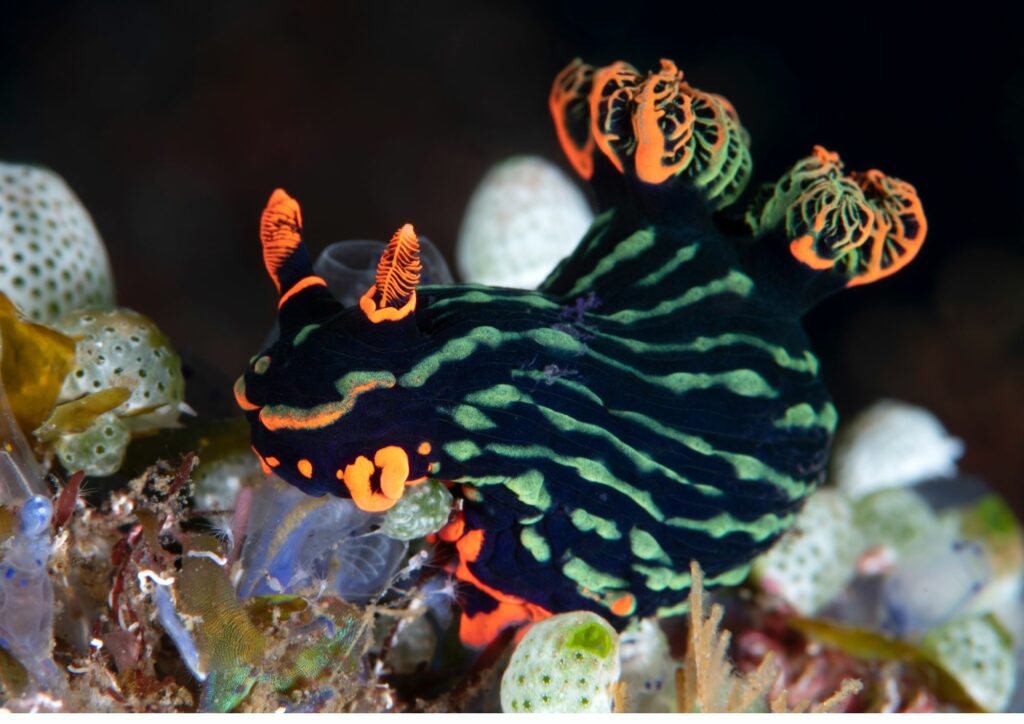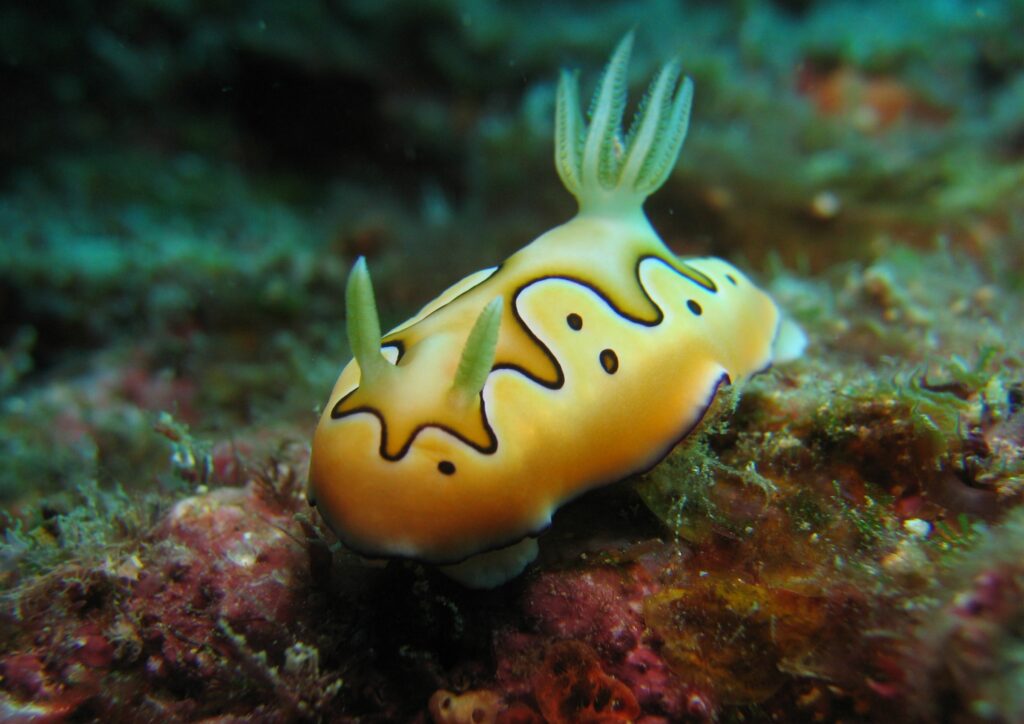Nudibranchs, often celebrated for their vibrant colors and unique shapes, are among the most captivating creatures of the ocean. These striking sea slugs may be small, with most measuring less than 2 inches (50mm), but they boast an astounding diversity, with approximately 3,000 species thriving worldwide, particularly in shallow, tropical waters.
Despite their beauty, nudibranchs lead a surprisingly brief life, generally living for less than a year. What makes them even more fascinating is their feeding habits; they primarily dine on hydroids and other tidepool inhabitants like ascidians and sea anemones. With a remarkable ability to regenerate crucial body parts for sensory functions, nudibranchs continuously intrigue marine enthusiasts and researchers alike.
The Diverse Species of Nudibranchs: A Global Perspective
Nudibranchs are a remarkable group of sea slugs with about 3,000 species identified worldwide, demonstrating an astonishing level of diversity. Most nudibranchs thrive in shallow, tropical waters, where they can often be seen gracefully navigating their vibrant environments. Generally, these fascinating creatures are quite small; most species measure under 2 inches (50mm) in length, making them easy to overlook. Their feeding habits are equally intriguing, as they primarily consume hydroids and other tidepool creatures, like ascidians and sea anemones, showcasing their role in marine ecosystems. Nudibranchs also have a unique set of curved teeth, known as a radula, which aids in their feeding practices.
Nudibranch Diet: Feeding on Tidepool Delicacies
Nudibranchs have a specialized diet primarily consisting of hydroids and other tidepool creatures such as ascidians and sea anemones. With their unique adaptive radula, which is a set of curved teeth, they can efficiently scrape and consume these soft-bodied organisms. This feeding strategy not only sustains their vibrant coloration but also plays a critical role in the marine ecosystem. Interestingly, most species of nudibranch, which number around 3,000 worldwide, are under 2 inches (50mm) in length, showcasing the diversity and intricacies of these tiny creatures. Their short lifespan of less than a year means nudibranchs must rapidly find food and reproduce, making their feeding habits essential for their survival in the shallow, tropical waters they inhabit.
Life Cycle of Nudibranchs: The One-Year Timeline

Nudibranchs have a remarkably brief life cycle, generally living less than a year. These vibrant marine mollusks often spend their short lives feeding primarily on hydroids and other tidepool creatures like ascidians and sea anemones. Throughout their life, nudibranch undergo various stages, starting as eggs laid in spirals or ribbons, which hatch into larvae. After metamorphosing, they develop into juveniles, gradually taking on their vibrant adult coloration. Interestingly, nudibranchs are also known for their regenerative abilities, allowing them to regrow body parts that are critical for sensory functions. Despite being very small, with most species under 2” (50mm) in length, they play a significant role in their ecosystems.
Sensory Superstars: The Regeneration of Body Parts
Nudibranchs are truly sensory superstars, renowned for their remarkable ability to regenerate body parts critical for sensory use. This fascinating adaptation allows these colorful sea slugs to thrive in their underwater habitats. Even though they generally live less than a year, nudibranch can regrow important sensory structures, enhancing their ability to navigate and interact with their surroundings. This regeneration capability not only promotes survival but also allows them to adapt to changing environments quickly. Exploring the world of nudibranchs unveils their unique biology and resilience, making them intriguing subjects of study for marine biologists and enthusiasts alike.
Size Matters: Understanding the Tiny Dimensions of Nudibranchs
Nudibranchs are remarkable creatures that showcase the beauty of the underwater world, especially considering their size. Generally, these vibrant sea slugs are very small, with most species measuring under 2 inches (50mm) in length. This miniaturization allows them to navigate their intricate tidepool habitats, feeding primarily on hydroids and other creatures such as ascidians and sea anemones. Despite their diminutive stature, nudibranchs boast diverse colors and patterns, which can serve as a warning to predators about their toxicity or unpleasant taste. Their small size does not detract from their fascinating adaptations, making them an intriguing subject for marine enthusiasts.
Unique Dental Features: The Role of Radula in Nudibranch Feeding
Nudibranch, known for their vibrant colors and unique shapes, possess a fascinating dental feature called radula. This specialized structure consists of a set of curved teeth that allow them to efficiently feed on hydroids and other tidepool creatures like ascidians and sea anemones. The radula acts like a rasping tongue, enabling nudibranchs to scrape their food from rocks and coral surfaces. This feeding mechanism is particularly crucial given that most nudibranchs are very small, with the majority measuring under 2 inches (50mm) in length. With about 3,000 species of nudibranchs found worldwide, each species boasts distinct adaptations that enhance its feeding habits in the diverse ecosystems of shallow, tropical waters.
Habitat and Distribution: Where to Find These Colorful Creatures
These creatures, with about ~3,000 species worldwide, predominantly inhabit shallow, tropical waters, making them accessible for divers and marine enthusiasts alike. These vibrant sea slugs can be found clinging to rocks, coral reefs, and tidepools, where they thrive among hydroids, ascidians, and sea anemones, their primary food sources. Generally small, most nudibranchs measure under 2 inches (50 mm), showcasing an array of colors that serve both as camouflage and a warning to predators. Interestingly, nudibranchs typically live for less than a year but display remarkable regenerative abilities, allowing them to regrow critical sensory body parts, enhancing their survival in diverse marine environments.
The Enchanting World of Nudibranchs Awaits
In conclusion, the vibrant universe of nudibranchs is nothing short of captivating. With their incredible diversity, estimated at around 3,000 species, and their striking appearances, these small creatures pack a punch in the marine ecosystem. From their unique feeding habits, which primarily include hydroids and other tidepool creatures like ascidians and sea anemones, to their fascinating ability to regenerate crucial body parts, nudibranchs exemplify the wonders of evolutionary adaptation.
Additionally, their short lifespan, generally less than a year, adds a layer of poignancy to their colorful existence in shallow tropical waters. As you explore the world beneath the waves, keep an eye out for these little wonders often measuring under 2 inches (50mm) in length. Their curved teeth, known as radula, signify that even the smallest creatures have brilliantly adapted tools for survival. The breadth of knowledge we gain from studying nudibranchs not only enriches our understanding of marine life but also highlights the importance of preserving oceanic environments.
Bali diving unveils a hidden world of vibrant colors and intricate patterns with the enchanting nudibranchs that inhabit its coral reefs. These tiny, soft-bodied sea slugs, often described as the “butterflies of the ocean,” captivate divers with their dazzling array of shapes and hues. From electric blues and vivid oranges to intricate patterns that seem almost otherworldly, nudibranchs offer a unique spectacle for those who take the time to look closely.
Bali’s warm, nutrient-rich waters create the perfect environment for these fascinating creatures, making it a hotspot for divers keen to explore the smaller, often overlooked wonders of the ocean. Each dive becomes a treasure hunt, where the reward is the sight of these delicate and diverse marine marvels, adding a new layer of excitement and discovery to your Bali diving adventure.

I never knew nudibranchs were so fascinating! I loved learning about their unique feeding habits and regenerative abilities. It’s amazing how much diversity can be found in such small creatures.
Hi Siti Fatimah, thank you for sharing your enthusiasm about nudibranchs! We’re thrilled to hear that you found their unique feeding habits and regenerative abilities fascinating. It’s indeed amazing how much diversity can be found in these small creatures. At Gill Divers, we’re passionate about marine life and its importance in our ecosystem. If you have any more questions or would like to learn more about nudibranchs or diving in Bali, feel free to contact us at +65 6734 9373 or [email protected]. We’d be happy to help. Have a great day!
I’m a huge fan of marine life, and nudibranchs are definitely one of the most interesting creatures I’ve learned about. Their bright colors and unique shapes make them stand out from the rest.
Hi Rohan, thanks for sharing your enthusiasm for nudibranchs! We’re glad to hear that you find them fascinating. At Gill Divers, we share your passion and strive to provide our customers with the best diving experiences possible. If you have any questions or want to learn more about Bali diving or other destinations, feel free to contact us at +65 6734 9373 or email [email protected]. We’d be happy to help you plan an unforgettable adventure!.
I had no idea nudibranchs were so tiny! It’s amazing how much they can accomplish with their small size. I love learning about new species and discovering more about the ocean.
Hi Emily, thank you for sharing your excitement about nudibranchs! Yes, they are indeed tiny but pack a big punch in terms of their unique features and abilities. It’s wonderful that you’re interested in learning more about these fascinating creatures. At Gill Divers, we’re passionate about marine life and conservation. We’d be happy to provide more information on nudibranchs or any other species you’re curious about. Feel free to reach out to us anytime at Tel: +65 6734 9373 or Email: [email protected]. We’re always here to help. By the way, did you know that Bali diving offers a unique opportunity to spot nudibranchs in their natural habitat? Our experienced guides can take you on an unforgettable adventure to explore the underwater world of these tiny marine marvels.